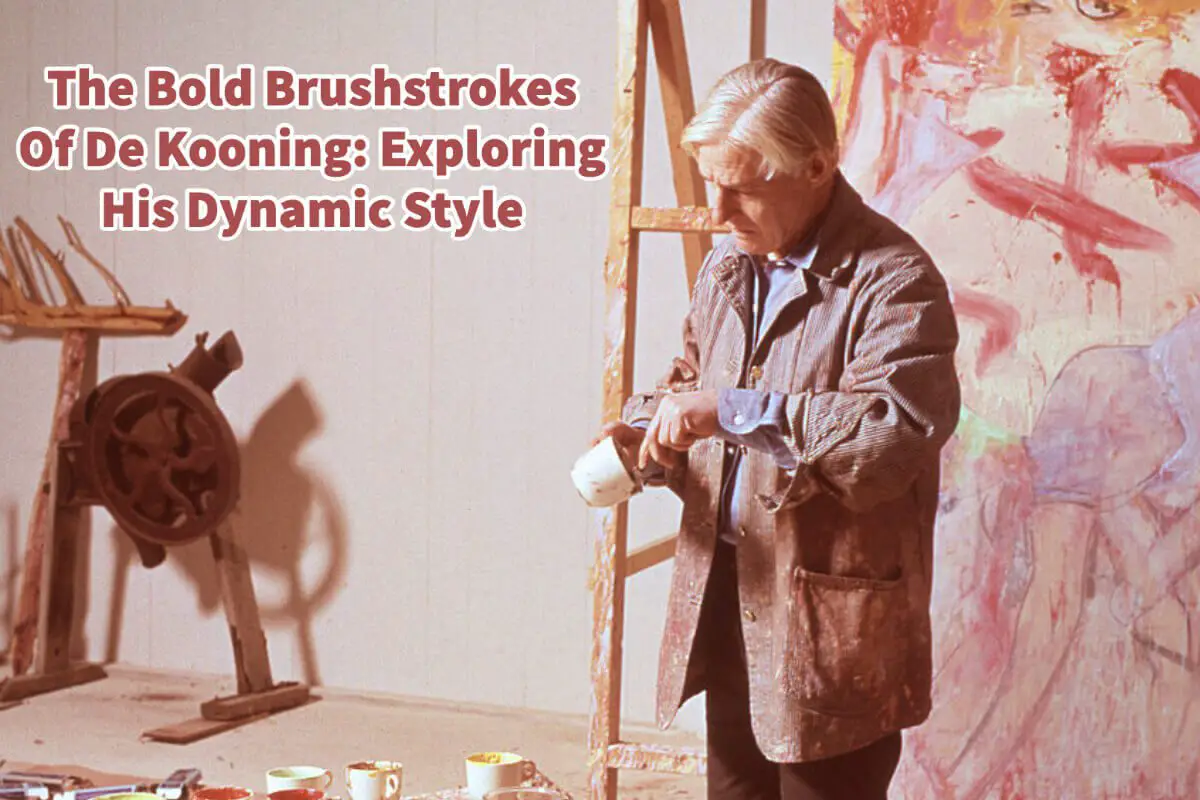One of my favorite Abstract Expressionism artists is Willem de Kooning. He has such unique and vibrant art.
Willem de Kooning was a dynamic Abstract Expressionism artist well known for the design elements he used to create his painting. He used design elements for his paintings, such as his brush strokes and how he painted. Read on as we explore Willem de Kooning’s life and dynamic artistic style.
Table of Contents
- Who Was The Abstract Expressionism Artist Willem De Kooning?
- 10 Design Elements of De Kooning’s Artistic Style
- De Kooning’s Use Of Bold, Gestural Brushstrokes
- De Kooning’s Use Of Vibrant Colors
- De Kooning Use Layered Compositions
- De Kooning Used Fragmented Forms
- De Kooning Had A Playful Use Of Texture
- De Kooning’s Use Of Juxtaposition Of Abstract And Figurative Elements
- De Kooning’s Exploration Of Light And Shadow
- De Kooning And His Innovative Use Of Materials
- De Kooning’s Bold Composition
- De Kooning And His Dynamic Sense Of Movement
- Frequently Asked Questions
- Related Questions
Who Was The Abstract Expressionism Artist Willem De Kooning?
Willem de Kooning was a Dutch-American painter who became a leading figure in the Abstract Expressionist movement. Born in Rotterdam in 1904, de Kooning moved to the United States in 1926.
Willem De Kooning loved art from an early age; he enrolled in Rotterdam’s Academy of Fine Arts at age 12. After moving to the United States, he worked odd jobs to support himself while continuing to paint in his spare time.
By the 1940s, he had become part of the emerging New York art scene and was one of the key figures in the Abstract Expressionist movement.
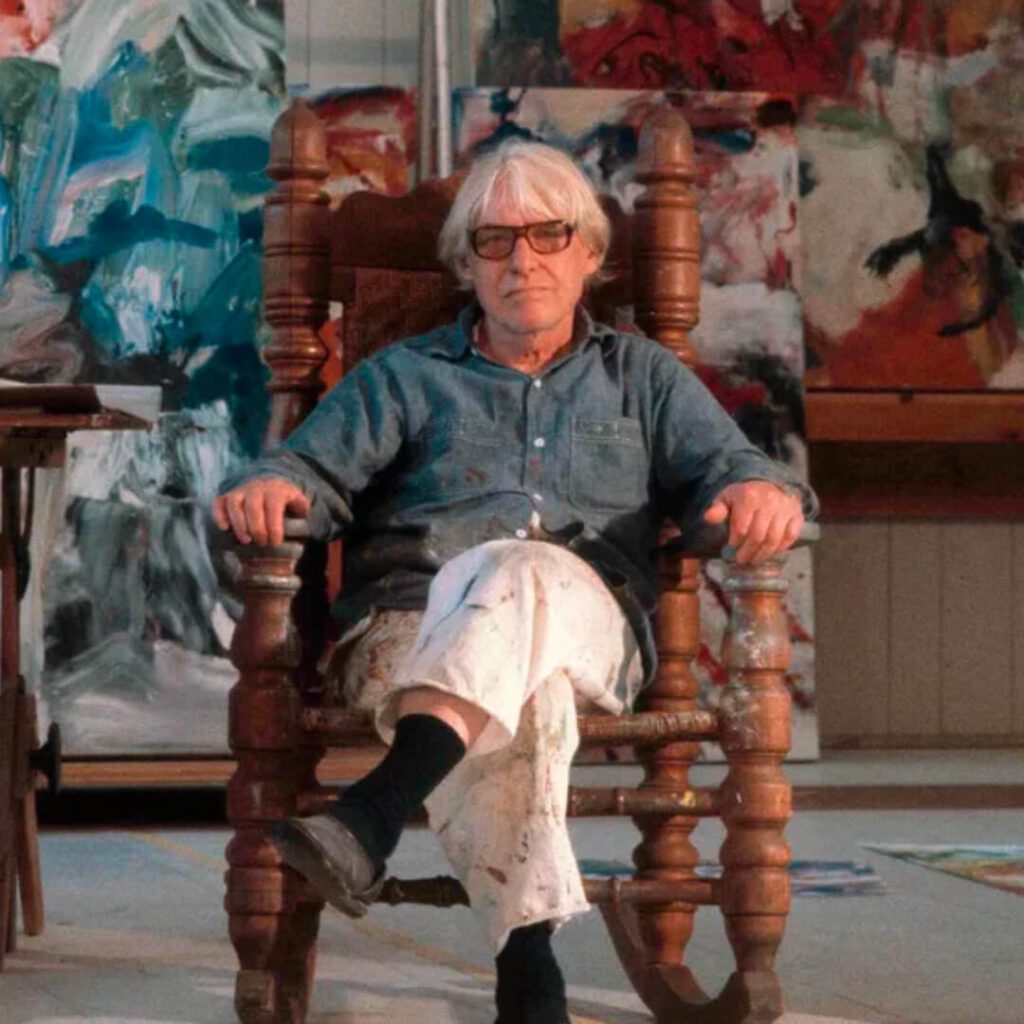
He is widely regarded as one of the most important painters of the 20th century, thanks in part to his dynamic, bold brushstrokes and his ability to create vibrant, engaging works of art.
Many people may not know this about Willem de Kooning, but despite their age difference, he became good friends with the Beatles star Paul McCartney. De Kooning inspired McCarthy to become an artist; McCartney had several internationally acclaimed art exhibitions.
You can discover more about this unique relationship in our blog post about Paul McCartney And Willem de Kooning’s Relationship And Art by clicking here.
Read on as we explore de Kooning’s life and work, and discuss 10 design elements that make his artistic style unique and vital.
10 Design Elements of De Kooning’s Artistic Style
Willem De Kooning’s importance as an artist stems from his ability to create engaging, dynamic, bold, and innovative compositions. His use of color and gestural brushwork helped to redefine the possibilities of painting, and his willingness to experiment with abstraction and the human figure continues to inspire new generations of artists.
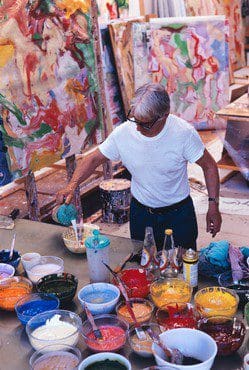
Here are 10 essential elements that he used in his art and how he used them.
De Kooning’s Use Of Bold, Gestural Brushstrokes
De Kooning was known for using thick, dynamic brushstrokes, giving his paintings energy and movement.
The use of bold gestural brushstrokes is one of the features that makes him a key Abstract Expressionism artist.
De Kooning’s Use Of Vibrant Colors
De Kooning’s bold, vibrant colors helped define the Abstract Expressionist movement, and his paintings are notable for their intense hues and contrasts.

De Kooning Use Layered Compositions
De Kooning often built up his paintings in layers, creating complex playful, and serious compositions. That is why when you see his paintings, you will see a layered-upon-layered effect.
De Kooning Used Fragmented Forms
De Kooning’s interest in the human figure is evident in his use of fragmented, abstract forms that suggest the human body and its movements.
Some of his most famous fragmented forms are how he used and drew inspiration from the female form.
De Kooning Had A Playful Use Of Texture
De Kooning’s paintings often feature a playful, almost childlike use of texture, with thick, impastoed paint creating a tactile, three-dimensional surface.
The use of these textured adds to a magnificent effect for his paintings.
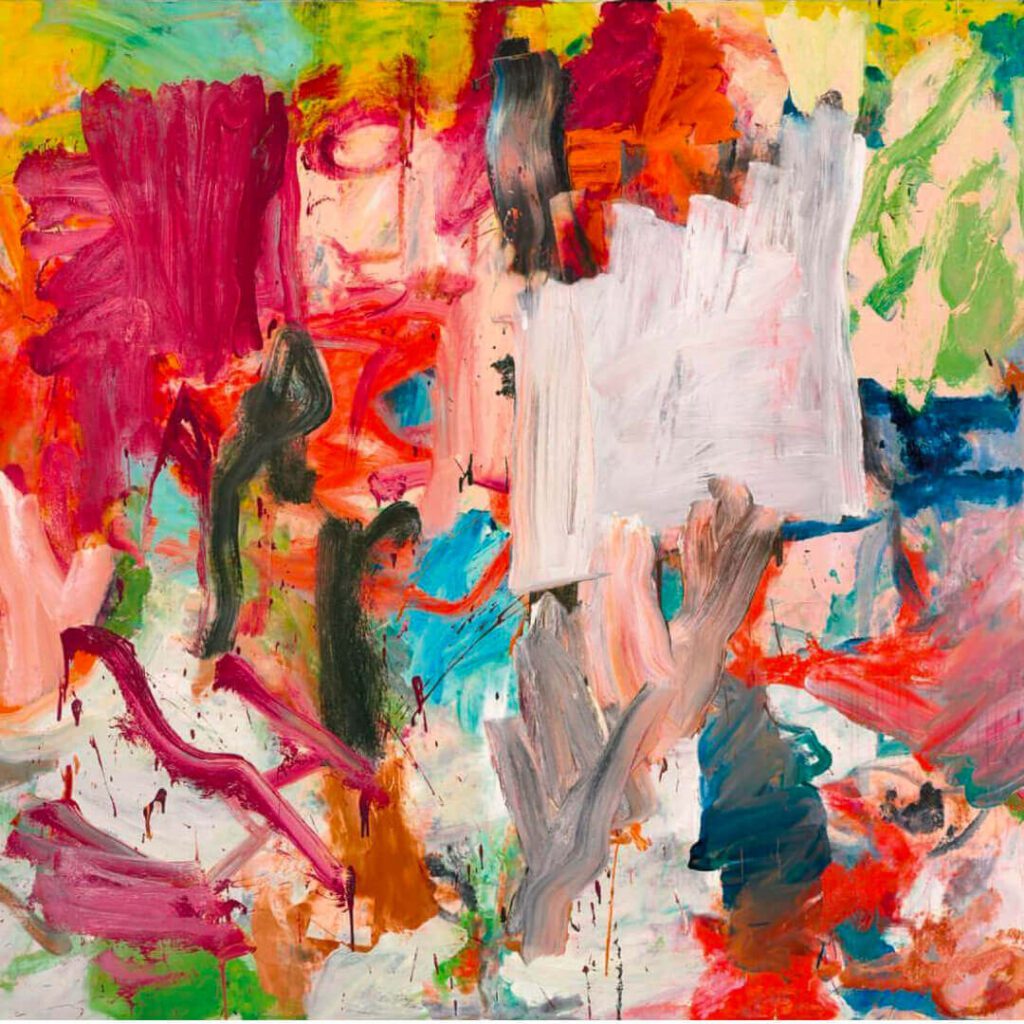
De Kooning’s Use Of Juxtaposition Of Abstract And Figurative Elements
De Kooning’s paintings often blur the line between abstraction and figuration, creating compositions that suggest both the human body and landscape. It is the blurring of these lines that make his paintings so unique.
De Kooning’s Exploration Of Light And Shadow
De Kooning’s use of light and shadow creates a sense of depth and dimensionality in his paintings, adding to their dynamic and engaging qualities. Like many other great artists, he understood how to use light and shadow to their full effect.
De Kooning And His Innovative Use Of Materials
De Kooning was known for his experimental use of materials, including household paints, and the incorporation of found objects into his work.
De Kooning’s Bold Composition
De Kooning’s paintings are characterized by their bold, innovative compositions, which often incorporate multiple layers of paint and a wide range of abstract forms.
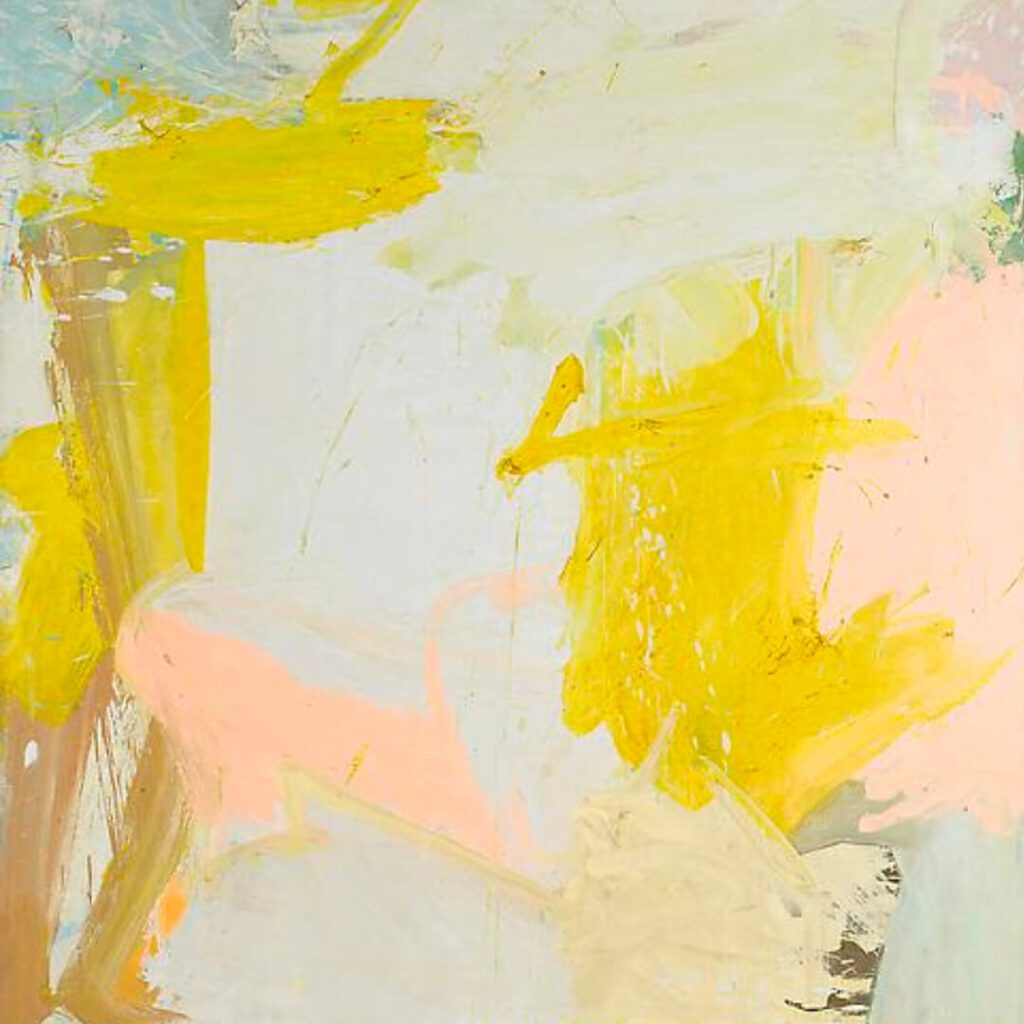
De Kooning And His Dynamic Sense Of Movement
De Kooning’s paintings are notable for their sense of movement, with the dynamic brushwork and abstract forms creating a sense of energy and motion.
As you can see from these 10 significant points, many artists can learn from Willem de Kooning. Willem de Kooning was a masterful painter with bold, dynamic brushstrokes and innovative use of color and composition that helped redefine the painting possibilities.

His ability to create engaging, vibrant works of art continues to inspire and influence artists worldwide, and his importance as a leading figure in the Abstract Expressionist movement cannot be overstated.
The 10 design elements we have discussed are just the many qualities that make de Kooning’s work such essential works of art and why Willem de Kooning will long be remembered as a vital figure of the Abstract Expressionism Movement.
Anita Louise Art is dedicated to art education, great artists, and inspiring others to find and create their art. We love art that uplifts and inspires. #ArtToMakeYouSmile! #ArtToMakeYouHappy!
If you are interested in seeing any of my art, you can find out more by clicking here. If you are interested in what inspires me and my paintings, you can discover more by clicking here.
We have a free newsletter and would love you to be part of our community; you can subscribe to the newsletter by clicking here. I would be happy to talk to you if you have any questions. You can reach me, Anita, by clicking here.
Subscribe to our Anita Louise Art YouTube Channel with great videos and information by clicking here.
Join us for our podcast “5 Minutes With Art.” Spend just 5 minutes a week with us to discover and learn about great art and artists. You can find out more about our podcast by clicking here.
Frequently Asked Questions
What defines Willem de Kooning’s dynamic style in Abstract Expressionism?
Willem de Kooning’s dynamic style is characterized by bold and energetic brushstrokes, spontaneous gestures, and a sense of improvisation. His paintings often convey a dynamic tension between abstraction and representation.
How did Willem de Kooning use brushstrokes as a distinctive feature in his artwork?
De Kooning’s brushstrokes were expressive and varied, ranging from aggressive and gestural to more controlled and deliberate. He used the brushstroke as a tool to convey emotion and movement within his paintings.
What role did design elements play in Willem de Kooning’s paintings?
Design elements, such as composition, color, and form, played a crucial role in de Kooning’s work. He carefully orchestrated these elements to create a harmonious yet dynamic visual experience in his paintings.
How did Willem de Kooning approach the balance between abstraction and representation in his art?
De Kooning often straddled the line between abstraction and representation. While his work was abstract, elements of figuration and recognizable forms would emerge, creating a dynamic interplay between the two.
What influenced Willem de Kooning’s artistic development and style?
De Kooning was influenced by various sources, including his exposure to European modernism, his association with other Abstract Expressionists, and his experiences in New York City. These influences contributed to the evolution of his dynamic and unique artistic style.
How did Willem de Kooning’s life experiences impact his artwork?
De Kooning’s life experiences, including his immigration to the United States from the Netherlands and his struggles with alcoholism, influenced the emotional depth and intensity of his paintings. His personal experiences often found expression in the bold brushstrokes of his art.
What is the significance of spontaneity in Willem de Kooning’s creative process?
Spontaneity was a key aspect of de Kooning’s creative process. He embraced the element of surprise, allowing the painting to evolve organically as he responded to the canvas. This spontaneity added vitality and dynamism to his works.
How did Willem de Kooning contribute to the Abstract Expressionist movement?
De Kooning was a prominent figure in the Abstract Expressionist movement, contributing to its development with his innovative approach to painting. His dynamic style, characterized by bold brushstrokes and emotional intensity, helped define the movement.
What are some key paintings that exemplify Willem de Kooning’s bold brushstrokes and dynamic style?
Paintings such as “Woman I,” “Excavation,” and “Easter Monday” are considered iconic examples of de Kooning’s bold brushstrokes and dynamic style. These works showcase his mastery in capturing movement and emotion on canvas.
How has Willem de Kooning’s legacy influenced contemporary art?
Willem de Kooning’s legacy continues to influence contemporary artists, particularly those interested in expressive and gestural painting. His dynamic style and willingness to push the boundaries of traditional artistic norms have left a lasting impact on the evolution of abstract and expressive art.
Related Questions
Why Are Mark Rothko’s Paintings Considered Special?
Mark Rothko’s paintings are remarkable because they are original works of art. He is one of the founders of the abstract expressionism movement and color field painting. But more than that, he believed that his spirit lives within the art and that we, the individuals, can view his art and be taken to a different realm.
By clicking here, you can learn more by reading Why Are Mark Rothko’s Paintings Considered Special?.
Who Is The American Artist Jackson Pollock (1912-1956)?
Some consider Jackson Pollock one of the most brilliant American abstract artists ever. Others consider his work of art as tossing around cans of paint by an artistic madman. One thing for certain is that Jackson Pollock is an important American abstract artist.
You can learn more by reading the blog Who is the American Artist Jackson Pollock (1912-1956)? by clicking here.
Who Was The Western American Artist Minerva Teichert (1888-1976)?
Minerva Teichert was, by all accounts, a cowgirl from Idaho who loved art. She studied art in both Chicago and New York. Minerva is known for her artwork of daily life in the Western United States, historical events, and scenes from the scriptures.
You can read more by reading our blog Who Was The Western American Artist Minerva Teichert (1888-1976)? by clicking here.

